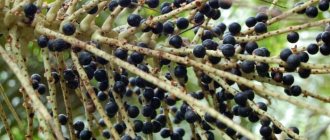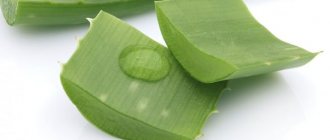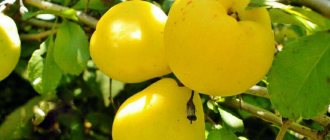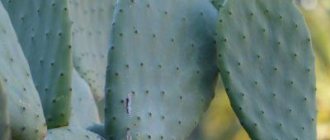≡ Home → Aloe → Types of aloe →
Aloe vera is a succulent plant that is grown at home for decorative and medicinal purposes, as well as on an industrial scale for the production of medicines and cosmetics. Its leaves contain more than 200 different substances, including vitamins and microelements, due to which it is considered very useful.
Young aloe vera bushes
The juice and extract of the plant are used in both folk and traditional medicine, but the indications for use vary significantly. Qualified doctors prescribe aloe preparations for wounds, minor burns and some skin diseases, but mainly in complex therapy. It is recommended to take the drug orally rarely and only as a laxative.
At the same time, aloe is used much more often in folk medicine. The drugs are used externally, taken orally, and even injected. With the help of aloe, diseases of the eyes, internal organs and general pathologies are treated. The product is especially popular in cosmetology. It is used to moisturize and nourish the skin, eliminate rashes and other defects.
Scientific research has shown that the properties of aloe are greatly overestimated by people, although in some cases it is quite an effective remedy.
What does aloe vera look like?
In the scientific literature, aloe vera is called true or Barbadensis Miller. This is one of the most common and medically valuable types of aloe. It looks like this:
Aloe vera has a herbaceous form. It has a shortened stem, almost invisible under the large fleshy leaves, which gather in dense leafy rosettes at its very base. The height of the plant and its diameter can reach 60-70 cm. As a rule, aloe grows to large sizes only in natural conditions and when grown in open ground, while in indoor plants the diameter of leaf rosettes rarely exceeds 30-40 cm.
Aloe vera leaves have a lanceolate shape and a fleshy texture. Inside they are divided into small cells, allowing them to retain a large amount of moisture, and on top they are covered with a dense peel. During periods of drought, its pores narrow, which prevents the evaporation of liquid. The surface of the leaves is smooth, but along the contour they are covered with sharp spines. The color is in most cases gray-green, but sometimes under the influence of the sun it can turn pale pink. This occurs mainly in wild species.
During flowering, a single peduncle, up to 50-70 cm high, grows from the center of the leaf rosette. At its top, a light green bud is first formed, which is very reminiscent of a cone. When it begins to bloom, a spear-shaped inflorescence appears. It consists of large tubular flowers, about 3-4 cm long and up to 1.5 cm in diameter. Their colors vary: there are flowers of yellow, orange, red and mixed shades. They do not bloom immediately, but gradually. The lower flowers open first, then the middle ones, and then the upper ones. Thanks to this, flowering lasts for 1-2 months.
An aloe vera inflorescence looks like this:
Biology of the species
The natural range of aloe vera remains unclear. The plant was introduced to many countries, where it successfully took root. Today it is cultivated on plantations in different parts of the world, and grown at home almost everywhere.
In the wild, the plant is distributed in the coastal regions of Africa, mainly northeastern. It is also found in the Arabian Peninsula, Canary Islands and Madeira.
Aloe vera as a street plant in Dubrovnik, Croatia
Aloe vera grows in hot, dry climates that are unfavorable to most other plant species. It is found on sandy and rocky soil in deserts, semi-deserts and mountains. The succulent is adapted to high temperatures and long periods of drought. It can go without watering or rain for about 2-3 months.
During the spring and summer, aloe vera grows actively, and in the fall and winter it begins a dormant period. It ends with a new flowering, which occurs in March-April. Due to the gradual opening of flowers, it lasts about one and a half months.
After flowering ends, an achene with small dark brown seeds is formed on the peduncle. With their help, aloe spreads in natural conditions. The plant also reproduces using basal shoots that appear in early summer.
Features of growing aloe vera at home
At home, aloe vera is grown mainly from root shoots and cuttings, which are rooted in sand or a special substrate. Seeds are also sometimes used.
Aloe vera is considered one of the least demanding plants. It takes root well in different conditions and does not require special care. To grow it, use a substrate for succulents, which is sold in flower shops, or self-prepared soil from a mixture of turf and leaf soil with sand. The soil is made loose so that it allows air to pass through and does not retain water.
The flowerpot is selected according to the size of the roots and the diameter of the leaf rosette. The roots should be placed in the flowerpot at a distance of 3-4 cm from its walls. In this case, the diameter of the pot must be no less than the leaves, otherwise they will begin to hang down and the plant will lose its decorative appearance.
It’s time to transplant the plant from this pot into a larger one.
The frequency of watering your succulent varies depending on the season. In the warm season, it is watered 2-3 times a month, and in the cold season - once every 3-4 weeks. During flowering, watering can be increased up to once a week.
You can fertilize the plant during the period of active growth. To do this, use liquid mineral fertilizers or folk remedies.
On a note
Before watering aloe vera, be sure to check that the top layer of soil is thoroughly dry. If you flood a plant, its roots will begin to quickly deteriorate, and the leaves, starting from the tips, will darken and dry out and wither. In this case, the only way to save the flower is by transplanting it.
Seasonal conditions for growing plants - table
| Watering | Lighting | Temperature | |
| Cold season | Once every four weeks, in the morning | It is possible to use artificial lighting, up to 15 hours a day | 10–15 ⁰C |
| Warm season | Once every two weeks, late in the evening | It is possible to gradually accustom it to direct sunlight by taking it out onto the balcony or into the yard. | Indoor or outdoor (including in direct sunlight) |
Medicinal properties of aloe vera
Scientists have found that aloe vera leaves contain about 200 biologically active components. They contain resinous substances, polysaccharides, organic acids, phenols, phytoncides, aloin, allontoin, essential oils, vitamins C, E and group B, as well as other substances. The amount of individual components in the leaves varies greatly. Some of them are contained in small doses.
Aloe vera juice is the main accumulator of biologically active substances and the main medicine in folk medicine.
Thanks to the extensive chemical composition of aloe vera, people attribute many beneficial properties to it. However, as a result of scientific research and clinical trials of drugs, only some of them were confirmed.
When used externally, aloe vera has been proven to provide:
- Regenerating effect;
- Anti-inflammatory;
- Antibacterial;
- Anesthetic.
This justifies the use of the product on the skin and occasionally on the mucous membranes of the mouth and throat. Aloe vera promotes healing of skin after wounds, sun and radiation burns, and other damage. The drug stimulates the formation of fibroblasts in injured areas of the skin, due to which the healing process occurs several times faster.
On a note
The wound healing effect of aloe was first officially confirmed in 1984. Then the director of the North Texas Scientific Laboratory, I.E. Danhof conducted a study which found that under the influence of aloe vera-based preparations, human skin heals 4-6 times faster after wounds and burns.
The antibacterial properties of aloe vera have also been confirmed. It manifests itself when used externally and only against staphylococcus, streptococcus and some enterobacteria. In 2021, Israeli specialists conducted a clinical trial of the drug and found that its effectiveness against enterobacteriaceae is not inferior to that of cephalosporin antibiotics.
A Petri dish with a colony of enterobacteria on which the bactericidal properties of aloe vera juice are tested
Aloe vera also has an anti-inflammatory effect. It suppresses inflammation on the skin, helps reduce redness and swelling. The product reduces irritation and rashes. In addition, it provides a mild analgesic effect.
It is also useful to read: Details about variegated aloe (tiger)
When used internally, these properties of aloe do not appear. His drugs:
- Have a laxative effect;
- Slightly increase the acidity of gastric juice;
- Stimulate bile formation;
- Slightly increases appetite.
All effects, except for the laxative, are very weak. Because of this, in traditional medicine the drug is not used to increase acidity or remove bile. It is used to relieve constipation, but is now quite rare. The drug gradually increases intestinal motility, due to which approximately 10 hours after its administration, emptying occurs.
Despite the fact that the properties of aloe vera and its effect on the human body have been studied in dozens of scientific studies, people attribute many more effects to this remedy than have been confirmed. It is believed that it strengthens the immune system and increases resistance to infectious and viral diseases. It is used for preventive purposes and to increase overall tone and vitality.
It is also believed that aloe vera’s antibacterial, anti-inflammatory and regenerating properties also occur when taken orally. Because of this, the drug is taken for pathologies of internal organs and general diseases. A very common myth is that aloe treats gastritis and ulcers by ensuring healing of the mucous membranes of the stomach and intestines.
In some traditional medicine reference books you can read that aloe vera also has antiviral and antifungal properties. He is credited with the ability to cure almost all diseases and is often called the immortelle. True, although aloe vera has certain healing effects, it is not a panacea. All effects that have not been scientifically proven remain speculative. The product continues to be used, relying on them, but there is no data on effectiveness.
On a note
The external difference between aloe vera and agave is very large, however, the differences in the chemical composition and properties are minimal. In medicine, these plants are considered interchangeable, since their therapeutic effectiveness does not differ.
On the left is aloe vera (young bush), on the right is aloe vera (adult plant)
In what cases are such drugs prescribed?
In traditional medicine, only drugs with proven effectiveness are used. Accordingly, aloe vera is used for its effects, which have been confirmed.
The drug is prescribed for:
- Minor skin damage (abrasions, scratches and cuts);
- Sun and radiation burns of 1st and 2nd degree, as well as for their prevention;
- Chapping and frostbite of the skin;
- Allergic irritation and insect bites;
- Some skin diseases.
Most often, the drug is used to heal the skin after cuts, minor burns and chapping in the cold. It is also used to reduce skin redness caused by an allergic reaction or insect bite. In this case, it is used as an adjuvant, as well as for dermatological diseases.
Internal use of aloe vera is rarely practiced in traditional medicine. Previously, it was often used as a laxative, but after the emergence of evidence of numerous side effects, the situation has changed. For example, the US Food and Drug Administration completely banned the production of the drug.
Dietary supplement based on aloe vera extract
In folk medicine, aloe vera is used much more often. It is used externally and internally to treat:
- Skin diseases, including herpes, psoriasis and eczema;
- Diseases of blood vessels and joints;
- Varicose veins on the legs;
- Eye pathologies such as conjunctivitis, cataracts and others;
- Runny nose and sore throat;
- Bronchitis, inflammation and even pulmonary tuberculosis;
- Gastritis and ulcers of the stomach and duodenum;
- Pancreatitis;
- Gynecological pathologies;
- Diabetes mellitus;
- Cancer and others.
People use the juice and pulp of aloe vera to make medicines to treat a variety of pathologies. How they are used also varies. For example, for eye diseases and women's diseases, injections are given with a plant extract. They are not used in traditional medicine due to lack of effectiveness and a high risk of side effects.
What can it be used for?
Aloe juice is used to treat various inflammatory diseases of different organs and systems. It is made from:
- subur – concentrated juice, which is obtained by evaporating moisture;
- oil;
- liquid extract.
The juice and compositions obtained from it are used to prepare ointments, gels, syrups as the only active ingredient or with the addition of medicinal infusions and extracts from other plants.
The effectiveness of aloe vera for external and internal use
Aloe vera preparations are effective for minor skin damage resulting from scratches, cuts and burns. The product accelerates tissue healing, reduces inflammation and has an antibacterial effect against several strains of bacteria. However, in case of severe inflammation, bacterial infection or fungus, its effectiveness is insufficient.
Aloe does not cure skin diseases. It is prescribed in complex therapy mainly to reduce peeling and heal the skin. Also, this remedy cannot eliminate an allergic reaction. It does not have such a property.
Due to the large number of biologically active components, aloe juice itself can cause severe allergies.
When taken internally, aloe vera has only a laxative effect. The choleretic effect and increased stomach acidity appear slightly. Other properties of the drug have not been scientifically confirmed. Accordingly, it is impossible to cure any serious disease with its help.
Features of the use of drugs in traditional medicine
In folk medicine, aloe vera is used quite often. There are many recipes for medicines based on it and methods for their use. For skin diseases, use whole leaves of the plant, their pulp and juice. They are most often used to make lotions and compresses. To treat sore throat, rinse solutions based on juice or extract are prepared. To cure a runny nose, drops are used. They are also used for inflammatory eye diseases.
Internal use of aloe is very popular. Its juice is drunk to improve immunity, treat colds and flu, diseases of the gastrointestinal tract and respiratory system. It is believed that the product treats inflammatory diseases, has an antibacterial and regenerating effect. In fact, when taken orally, such properties do not appear, and the drug does not help cure these pathologies.
Practice shows that aloe juice cannot cure any serious disease.
To treat complex diseases of internal organs, injections are also given. Doctors of traditional medicine do not prescribe them, but the popularity of the procedure among the people does not decrease, despite its pain and ineffectiveness. Injections are carried out for deterioration of vision, clouding of the vitreous body and other eye pathologies, as well as for gastritis and ulcers, adhesions in the fallopian tubes in women, fibroids and other diseases in gynecology. In addition, injections are made for bronchitis and pneumonia, prostatitis, potency disorders, cancer and many other diseases.
On a note
It is believed that an extract from biostimulated aloe leaves triggers a number of processes in the human body aimed at self-healing and healing. This theory was put forward in the 50s of the last century by ophthalmologist V.P. Filatov. Experimentally, he discovered that so-called biostimulants are synthesized in the leaves of aloe, placed for some time in low temperature conditions. They enhance all the vital functions of the plant and prevent it from dying. The scientist suggested that they would also act on the human body.
Further research showed that this theory is false and plant biostimulants are ineffective. The scientist’s discovery did not find practical application, but thanks to his theory, the popularity of the remedy among the people increased greatly.
It is also useful to read: Aloe vera as a houseplant and home remedy
Medicinal properties and contraindications to the use of aloe injections
The liquid extract contains all the healing properties of the plant, which can relieve inflammation, swelling, defeat infection and exacerbation of chronic diseases. When taking aloe in the form of injections, the process of tissue regeneration at the cellular level is launched. In general, a barrier is formed in the body to infections and viruses due to the strengthening of the natural functions of the immune system.
Injections effectively suppress the pathogenic sphere, blocking access to the body for streptococcal, staphylococcal bacilli and typhoid fever
The beneficial effects of aloe extract injections have also been noted for the nervous system. There is an increase in the production of dopamine, which regulates nervous irritability. Men suffering from prostatitis and some other sexual diseases will also appreciate this medicine. Contraindications for injections are the same as for using aloe juice.
The use of aloe vera in cosmetology
Aloe vera is a popular component of cosmetics for facial and body skin care, as well as shampoos and hair conditioners. Many well-known companies add it to their products, such as Oriflame, Avon, L'Oreal and others.
In cosmetology, aloe vera is used to moisturize and nourish the skin, increase its elasticity and rejuvenation, prevent wrinkles, eliminate acne and obtain some other effects. By adding the juice or extract of this plant to a cream, tonic, soap, peeling or other product, manufacturers attribute all these properties to them. However, most of them remain unconfirmed.
Very popular shower gel from Aloe-Aloe
All cosmetic effects of the drug are based on its three main properties, which manifest themselves when used externally. Thanks to them, aloe vera provides:
- Moisturizing the top layer of skin;
- Healing of small wounds and scratches;
- Skin restoration after sunburn;
- Reduced redness;
- Elimination of peeling and irritation;
- Reducing rashes.
The product helps reduce the number of acne due to its antiseptic and anti-inflammatory effects, but does not completely eliminate them. It also soothes and restores skin after sunbathing, which is why it is often added to panthenol-based sprays. Aloe also reduces inflammation and accelerates healing of the mucous membranes of the mouth and throat, so it is even added to toothpastes.
Contraindications and possible side effects
You should not apply aloe vera preparations to the skin or drip it into your nose unless you are allergic to this plant. There are much more contraindications to the internal intake of drinking concentrates, syrups, teas, dietary supplements and other products.
One of the aloe vera-based drugs is prohibited for use for gastritis.
Aloe vera is contraindicated for:
- Complex cardiovascular diseases;
- Functional and inflammatory diseases of the kidneys and intestines;
- Diseases of the gallbladder and bile ducts;
- Oncological pathologies;
- Gastritis with high acidity;
- Diarrhea;
- Hemorrhoids;
- Abdominal pain, the cause of which has not been established;
- Bleeding;
- Pregnancy and lactation;
- Children under 12 years of age.
It is noteworthy that these contraindications are listed only in the instructions for liquid aloe extract, which is sold in pharmacies, as well as in medical reference books. In the description of tablets and capsules that are classified as dietary supplements, they are most often not indicated. For example, in Solgar and Forever brand drugs, only allergies are listed as contraindications.
For this dietary supplement, the instructions list only allergies as a contraindication.
The use of the drug, despite existing contraindications, can lead to serious complications. Cases have been recorded where aloe provoked inflammatory changes in the intestines, increased blood pressure, increased bleeding, diarrhea and other side effects. It is also thought to cause uterine contractions and cause miscarriage or premature birth.
Also, when treating aloe vera, you need to take into account the real effectiveness of the product. When used instead of properly selected and effective therapy, diseases can progress, worsen and enter the chronic stage.
Medicinal properties and contraindications for the use of liquid aloe extract
Indications for use are the following diseases: peptic ulcer, persistent loss of appetite, enterocolitis, neuralgia, cholecystitis, asthma, headaches, tuberculosis, problems with vision, hearing and smell.
Liquid aloe extract comes not only in the form of injections, but also in the form of syrups, solutions and even tablets. You should not use such drugs with hypersensitivity to the composition of the extract, high blood pressure, cystitis, or hemoptysis.
Is it possible to eat aloe vera
Aloe vera leaves are added to salads and used as a side dish for meat and fish dishes. They have a bitter smell and taste, but many people like them. They are eaten mainly to saturate the body with vitamins and other beneficial substances contained in them, and as a result, to strengthen the immune system and increase overall tone. Aloe leaves are also included in weight loss diets. It is believed that the plant helps cleanse the body of toxins and waste.
Expert opinions on the safety of eating aloe vera vary. Some sources write that it can provoke the development of cancer, and this is indeed true. The peel of the plant contains aloin, a substance that becomes carcinogenic in large doses. This has been confirmed in animal studies. In 2013, it was found that aloin causes the development of gastric hyperplasia and colon cancer in rodents. Based on such data, the International Agency for Research on Cancer has listed aloe whole leaf extract as a possible human carcinogen.
If aloe were not carcinogenic, it would be an excellent source of food - each leaf is very juicy and massive.
Eating aloe vera, as well as drinking its juice, is possible if there are no contraindications. The dangerous substance is contained only in the peel of the plant, but is absent in its pulp, so it is recommended to peel the leaves before consuming them.
How to prepare preparations based on aloe
For medicinal use, the largest and fleshiest aloe vera leaves are chosen. It is believed that the plant must be more than 3 years old in order for a sufficient amount of useful substances to accumulate in it.
The selected leaves are cut as close to the stem as possible, after which they are washed and cleared of thorns and peel. As a result, stripes of translucent pulp remain. To make juice, it is cut into small pieces. Squeeze it out using gauze or a juicer.
Freshly cut leaves, leaf cut into pieces and ready-made aloe juice in a spoon
Some traditional medicine recipes are based on using aloe pulp directly. In these cases, it is cut into smaller pieces and lightly crushed until the juice is released. Also, other components are often added to medicines, for example, honey, Cahors, essential oils and herbal infusions.
Chemical composition
In terms of the amount of useful substances, aloe is a record holder. It contains more than 270 different chemical compounds. This includes not only minerals, vitamins and amino acids that are so necessary for the body, but also other plant substances:
- Anthraquinines . Thanks to them, aloe pulp and juice have a mild laxative effect.
- Glucocides and isobartoloins are active defenders of the body, killing microbes and viruses.
- Antranols are activators of oxygen metabolism in cells.
- Allontoins – increase skin elasticity and saturate it with moisture.
In addition to these substances, there are essential oils, saponins and other useful acids.
Aloe is one of the most controversial plants; it is around this flower that disputes most often arise regarding its harm and benefits.
How to use aloe vera
In folk medicine, there are many different recipes based on aloe vera and no less ways to use them. The drugs are applied to the skin and lotions and compresses are made with them, used as drops for the eyes and nose and solutions for rinsing the mouth and throat. They are also taken orally and injected, and for gynecological pathologies they are used as suppositories and tampons. This use of aloe vera is not practiced in traditional medicine.
For use on the skin, aloe juice and pulp are most often used, but sometimes whole leaves are used. For example, to draw out pus, they are cut in half and applied with the cut to the abscess.
Aloe vera juice or pulp and preparations based on them are also taken orally. For different diseases, the duration and dosage of medications vary. On average, it is recommended to drink the plant juice 1 teaspoon 2 or 3 times a day for a month. The course of treatment with injections is also long. They are carried out within 30-45 days.
How to make agave bloom at home?
Aloe blooms very rarely, about once every 20 years (with good care, perhaps earlier), mainly in the cold season. Most often, only one flower appears, always in the axils of the upper leaves. The spectrum of colors can vary from bright yellow to red. In order to help the plant bloom, you need to provide it with a period of rest.
The aloe flower contains a lot of nectar, due to this it has a strong, specific, although pleasant, smell.
Aloe blooms more than once every hundred years, as is commonly believed: flowering can be achieved with proper care










